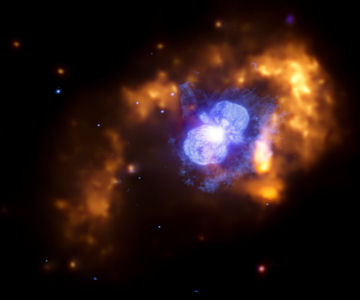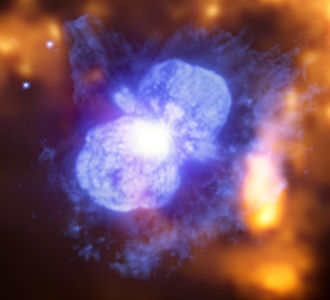 “It’s time to move on, son! Real science… try it!”
“It’s time to move on, son! Real science… try it!”
It’d dead. Dead, I tell you.
Bad Astronomy drew my attention to the Eta Carinae stuff at Harvard’s Chandra X-Ray Observatory site.
The Chandra site says this:
Eta Carinae is a mysterious, extremely bright and unstable star located a mere stone’s throw – astronomically speaking – from Earth at a distance of only about 7,500 light years. The star is thought to be consuming its nuclear fuel at an incredible rate, while quickly drawing closer to its ultimate explosive demise. When Eta Carinae does explode, it will be a spectacular fireworks display seen from Earth, perhaps rivaling the moon in brilliance.
Now, I’ll take issue with a couple of points there.
#1, while I know it’s true that 7500 light years is “right in our neighbourhood” in terms of the size of everything that is, can we please have a little awe that we’re looking at pictures of something that’s around 7 x 1016 kms away? Yes, sixteen zeros. It’s part of the glorious wonder of science that I can even think about something existing that far away, much less deduce things about its behaviour, much less actually see it!
#2, let’s not go with that “when it does explode” language. What you want to say is “when the light from its explosion reaches us”. It’s 7500 light years away. That means that what we’re seeing now is how it looked right around the time the Egyptians were figuring out agriculture. If it looks like an explosion is imminent, then that baby already happened. It’s already dead.
The blue things in that picture look like this if you grab the relevant segment of the high-res image from Chandra:
What are they? Well, they’re lobes of cooling debris. The image is actually a composite, with the blue bits being an actual picture (i.e. visible light, optical image, etc) that the Hubble can see, and the orange and red bits are X-ray results from Chandra. Well, here’s what Chandra says:
In the 1840s, Eta Carinae had a massive eruption by ejecting more than 10 times the mass of the sun, to briefly become the second brightest star in the sky. This explosion would have torn most other stars to pieces but somehow Eta Carinae survived.
So the blue bits show the debris from that eruption, and the other colors show the X-rays given off as thrown off material smacks into gases and dust around the sun. That’s pretty cool.
In that quote, “in the 1840s” here should be read as “in 5660 BC or so”. What they mean is that the eruption became visible here in the 1840s. Unless they have some FTL technology at Harvard that I don’t know about. Damn secretive brahmins.
Forget that, though, and read this bit again: “more than 10 times the mass of the sun”. I’m not sure I can put my reaction to this better than the Bad Astronomy guys did:
That’s 20 octillion tons of gas (20,000,000,000,000,000,000,000,000,000) it ejected at about a million miles per hour, in case you’re not getting enough awesome in your diet.
The Bad Astronomy post lays out a little science about stellar formation and spectrography out to explain A) how we know what’s going on in a star that far away, and B) how we know that the thing’s going to blow in the next thousand years at most (which, again, means “already blew more than 6500 years ago” remember).
Even better, though, is this bit:
Note that the lobes appear to be tilted away from us by about 40 degrees or so. That’s a good thing. When stars like Eta Carinae explode, they tend to shoot of beams of energy and matter that, at its distance of 7500 light years, could kill every living thing on Earth. But since it’s pointed away from us, all we’ll get is a spectacular light show. If you’re keeping score at home, gamma-ray burst aimed at you = bad, pretty supernova with no accompanying high energy radiation = good.
So, on the plus side, no species extinction by death ray is coming in the next thousand years (at least not from Eta Carinae). On the down side, that also means no post-apocalyptic society of green monsters fighting to see which one is really “strongest one there is“.
Your science fiction question of the day: What if we had found that it was pointing at us. What do you think happens if the scientists tell us that we have some random amount of time, but no more than 1000 years, before a death ray eliminates all life on this planet? (I admit that given the reaction to climate change science, I’m pretty pessimistic about this question.)
One final note, to think about during a late night session: Take a look at that lobes picture again, but with it alternately coloured. Remind you of anything you’ve seen before? Maybe anything similar to this image?




4 comments for “Professor Membrane On: A Dead Supernova”